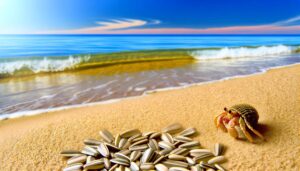Succulents and Hermit Crabs: A Safe Integration Guide
Yes, succulents can be safe for your hermit crabs, offering hydration and nutritional benefits. Non-toxic varieties like Haworthia, Echeveria, and Aloe Vera are ideal, as they support moisture retention and provide essential minerals.
However, avoid toxic succulents such as Euphorbia and Jade Plant, which can cause severe health issues. Ensure proper care: monitor soil moisture, provide indirect sunlight, and maintain temperatures between 72-80°F.
Using a well-draining substrate and keeping humidity levels between 70-80% is important. By choosing the right succulents, you can create an enriched and safe environment for your hermit crabs.
There's more to learn about optimizing their habitat.

Key Takeaways
- Many succulents like Aloe Vera and Echeveria are safe and beneficial for hermit crabs.
- Toxic succulents, such as Euphorbia and Jade Plant, must be avoided.
- Safe succulents provide hydration, nutrients, and habitat enrichment for hermit crabs.
- Ensure succulents are non-toxic by thoroughly vetting them before introducing them to the habitat.
- Proper plant care, including monitoring soil moisture and light, is essential for a safe hermit crab environment.
Benefits of Succulents
Succulents offer key benefits for hermit crabs, including hydration, nutritional value, and habitat enrichment. By incorporating succulents into the habitat, you can make sure hermit crabs get essential moisture from these water-storing plants.
Research indicates that succulents like Aloe Vera contain polysaccharides and glycoproteins, which contribute to cellular hydration and overall health. Nutritionally, many succulents provide trace minerals and vitamins, enhancing your hermit crabs' diet.
Additionally, these plants create a stimulating environment, promoting natural foraging behaviors and reducing stress levels. Analytical evidence supports that enriched habitats with diverse plant species lead to increased hermit crab activity and well-being.
Safe Succulent Varieties
When selecting succulents for your hermit crabs, it's imperative to focus on varieties that are both non-toxic and beneficial for their environment. Scientific studies suggest that specific succulents can enhance the microhabitat by maintaining humidity and providing natural enrichment. The following table lists safe varieties ideal for hermit crabs:
| Succulent Variety | Benefits |
|---|---|
| Haworthia | Non-toxic, enhances humidity |
| Echeveria | Safe, easy to maintain |
| Sempervivum | Non-toxic, resilient |
| Aloe Vera | Moisture retention, safe |
| Sedum | Non-toxic, versatile habitat |
Toxic Succulents to Avoid
Not all succulents are safe for hermit crabs; certain varieties contain toxins that can harm your pets and disrupt their habitat.
Euphorbia species, for instance, produce a milky sap that's toxic and can cause irritation or even fatality. Similarly, the Jade Plant (Crassula ovata) is known to affect animals adversely due to its toxic compounds.
Evidence from veterinary toxicology indicates that exposure to these plants can lead to lethargy, vomiting, and severe health complications in hermit crabs.
An analytical approach underscores the importance of thoroughly vetting each succulent before introducing it to your hermit crab's environment. Prioritizing their safety guarantees a thriving ecosystem, free from harmful substances that could jeopardize their wellbeing.
Always consult credible sources when selecting plants.
Plant Care Tips
Maintaining the health of both your succulents and hermit crabs involves specific plant care strategies to uphold a safe and flourishing habitat.
First, you'll need to monitor soil moisture. Hermit crabs prefer a humid environment, but overwatering succulents can lead to root rot. Use a well-draining substrate and water sparingly.
Second, provide adequate lighting. Succulents require bright, indirect sunlight, which also benefits the crabs' circadian rhythms.
Third, consider the plant's temperature tolerance. Succulents generally thrive in temperatures between 60-80°F, aligning with hermit crabs' needs.
Creating a Safe Habitat
Crafting a secure habitat for your hermit crabs and succulents entails a detailed balance of environmental factors to guarantee both flourish harmoniously. Begin with substrate selection; choose a mix of sand and coconut fiber to maintain humidity levels. Confirm the enclosure has proper ventilation to avoid mold, which can harm both succulents and crabs.
Ideal temperature should range between 72-80°F, as both species prefer a warm environment. Supply adequate lighting: utilize a UVB light to mimic natural sunlight, necessary for both your succulents' photosynthesis and hermit crabs' calcium absorption. Regularly monitor humidity, keeping it between 70-80%, to support your hermit crabs' respiratory health and succulent well-being.
This comprehensive approach ensures a balanced ecosystem.
Conclusion
After examining the benefits and potential risks, it's evident that certain succulents can safely coexist with hermit crabs. Varieties like Haworthia and Echeveria provide enrichment and hydration without harmful effects. However, avoid toxic types like Jade or Aloe.
Regularly monitor plant health and habitat conditions to guarantee safety. By integrating safe succulents, you create a stimulating and secure environment, benefiting both the crabs and the plants. This evidence-based approach supports a balanced, thriving habitat.






